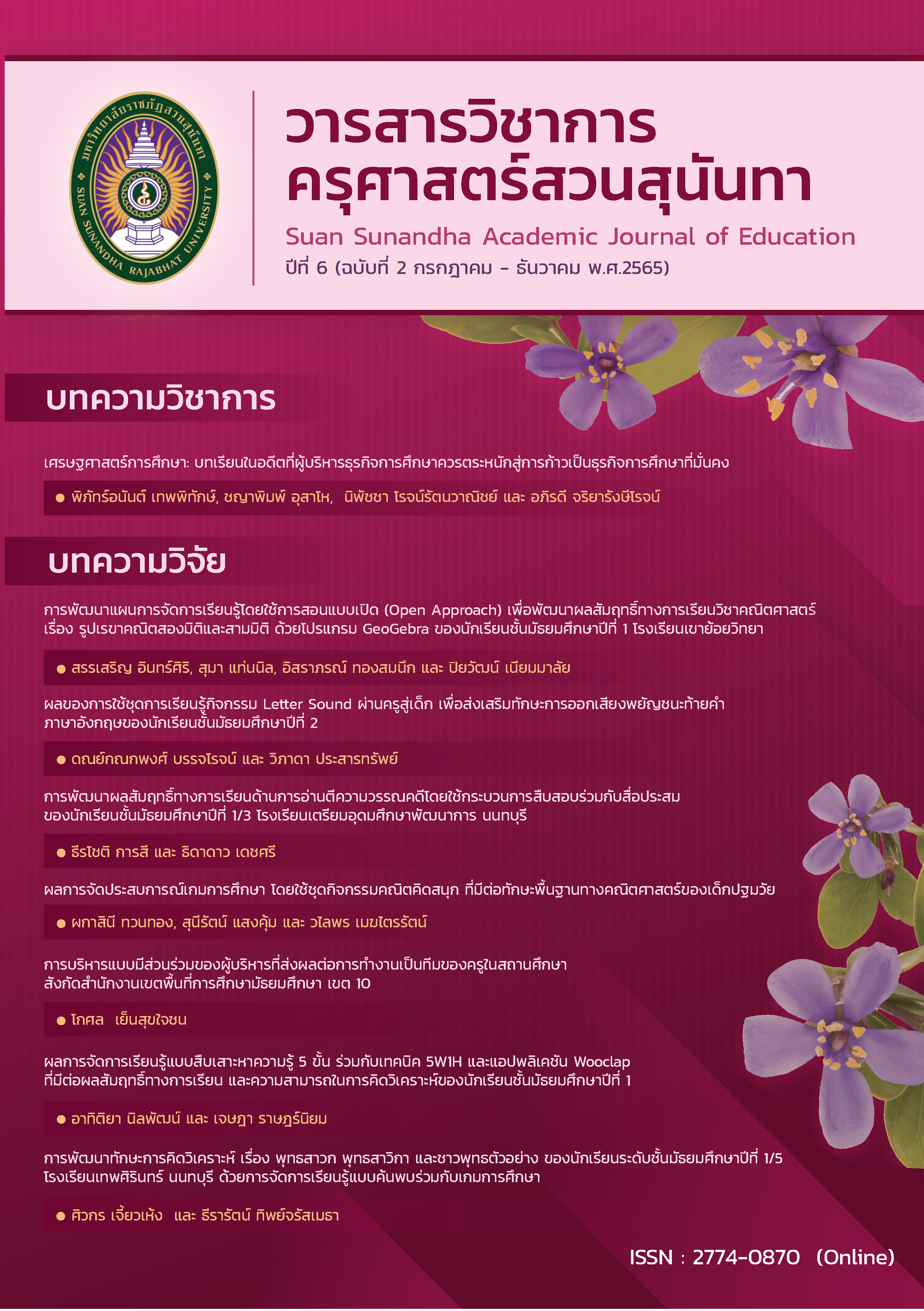เศรษฐศาสตร์การศึกษา: บทเรียนในอดีตที่ผู้บริหารธุรกิจการศึกษา ควรตระหนักสู่การก้าวเป็นธุรกิจการศึกษาที่มั่นคง
คำสำคัญ:
เศรษฐศาสตร์การศึกษา, , ผู้บริหารธุรกิจการศึกษา, ธุรกิจการศึกษา, นักเศรษฐศาสตร์ทางการศึกษาบทคัดย่อ
เศรษฐศาสตร์การศึกษาผลตอบแทนทางธุรกิจการศึกษาปัจจัยในอดีตที่ส่งผลต่อเนื่องบางประเด็นมาถึงปัจจุบัน พร้อมการวิเคราะห์ประยุกต์หลักทฤษฎีและแนวคิดเกี่ยวกับด้านเศรษฐศาสตร์การศึกษาที่ผ่านมา ผสมกับแนวทางการพัฒนาธุรกิจการศึกษาให้คงอยู่ โดยมีองค์ประกอบที่มีความสำคัญต่อการบริหารธุรกิจการศึกษา เช่น ประชากร เพศ ค่าแรง
ความคาดหวังของการเรียน แรงจูงใจ ผลตอบแทนของธุรกิจการศึกษาที่สามารถประเมินออกมาเป็นรูปแบบของตัวเงินที่วัดได้และมีส่วนที่ไม่สามารถประเมินออกมาเป็นตัวเงินได้ หลักการบริหาร 4M ได้แก่ คน เงิน วัสดุ และวิธีการบริหารทุนมนุษย์ ส่วนสำคัญของการบริหาร ในอดีตและปัจจุบัน ปัจจัยของการเพิ่มเงินระดมทรัพยากรเพื่อธุรกิจการศึกษา ดำรงอยู่รอดและก้าวทันต่อโลกของการเปลี่ยนแปลง สิ่งที่เสริมแรงจูงใจและความต้องการของผู้เรียนรูปแบบการจัดการเรียนการสอน
ที่มุ่งสอดคล้องกับนโยบายของทางภาครัฐ
คำสำคัญ: เศรษฐศาสตร์การศึกษา, ผู้บริหารธุรกิจการศึกษา, ธุรกิจการศึกษา, นักเศรษฐศาสตร์ทางการศึกษา
เอกสารอ้างอิง
ชัย สันกว๊าน และ พูนชัย ยาวิราช. (2557). ยุทธศาสตร์การบริหารจัดการโรงเรียนขนาดเล็กในอนาคต (พ.ศ. 2556-2565) สังกัดสำนักงานคณะกรรมการการศึกษาขั้นพื้นฐาน เขตภาคเหนือตอนบน. วารสารราชพฤกษ์, 12(2), 45-53.
พระราชบัญญัติงบประมาณรายจ่ายประจำปี. (2561). ราชกิจจานุเบกษา. (เล่ม 135 อตนที่ 71ก, น. 1-177).
ภาวิณี ศิริโรจน์. (2560). ศึกษาและพัฒนาชุดอดิเรกศิลปหัตถกรรม เพื่อส่งเสริมสุขภาพผู้สูงอายุ. การประชุมวิชาการมหาวิทยาลัยเทคโนโลยีราชมงคล ครั้งที่ 9 "ราชมงคลสร้างสรรค์นวัตกรรมที่ยั่งยืนสู่ประเทศไทย 4.0". (น. 234-244).
Acemoglu, D., & Angrist, J. D. (2001). Consequences of employment protection? The case of the Americans with Disabilities Act. Journal of Political Economy, 109(5), 915-957.
Ashenfelter, O., Harmon, C., & Oosterbeek, H. (1999). A review of estimates of the schooling/earnings relationship, with tests for publication bias. Labour economics, 6(4), 453-470.
Becker, G. S. (1962). Investment in human capital: A theoretical analysis. Journal of political economy, 70(5, Part 2), 9-49.
Bennis, W. G., & Townsend, R. (1989). On becoming a leader (Vol. 36). Reading, MA: Addison-Wesley.
Brodzicki, T. (2011). Augmented Solow Model with Mincerian Schooling and Infrastructure Externalities (No. 1101). The Univeristy of Gdansk, Faculty of Economics, Economics of European Integration Division.
Card, D. (1999). The causal effect of education on earnings. Handbook of labor economics, 3, 1801-1863.
Comay, Y., Melnik, A., & Pollatschek, M. A. (1973). The Option Value of Education and the Optimal Path for Investment in Human Capital. International Economic Review, 14(2), 421–435.
De la Fuente, A., & Ciccone, A. (2003). Human capital in a global and knowledge-based economy (Vol. 918). Luxembourg: Office for Official Publications of the European Communities.
Dee, T. S. (2004). Are there returns to civic engagement? Journal of Public Economics, 88, 1697-1720.
Delaney, L., Harmon, C., & Redmond, C. (2011). Parental Education, Grade Attainment and Earnings Expectations: Evidence from University Students. Economics of Education Review, 30(6), 1136-1152
Dickson, M., & Smith, S. (2011). What determines the return to education: an extra year or a hurdle cleared? Economics of education review, 30(6), 1167-1176.
Drucker, P. F. (2020). The essential drucker. Routledge.
Harmon, C., Oosterbeek, H., & Walker, I. (2003). The returns to education: Microeconomics. Journal of economic surveys, 17(2), 115-156.
Haveman, R. H. & Wolfe, B. L. (1984). Schooling and economic well-being: The role of nonmarket effects. The Journal of Human Resources, 19(3), 377-407.
Heckman, D. S., Geiser, D. M., Eidell, B. R., Stauffer, R. L., Kardos, N. L., & Hedges, S. B. (2001). Molecular evidence for the early colonization of land by fungi and plants. science, 293(5532), 1129-1133.
Heckman, J. J., & Urzua, S. (2010). Comparing IV with structural models: What simple IV can and cannot identify. Journal of Econometrics, 156(1), 27-37.
Heckman, J. J., & Vytlacil, E. (2005). Structural equations, treatment effects, and econometric policy evaluation 1. Econometrica, 73(3), 669-738.
Heckman, J. J., Lochner, L. J., & Todd, P. E. (2006). Earnings functions, rates of return and treatment effects: The Mincer equation and beyond. Handbook of the Economics of Education, 1, 307-458.
Heckman, J. J., Lochner, L. J., & Todd, P. E. (2008). Earnings functions and rates of return. Journal of human capital, 2(1), 1-31.
Lochner, L., & Moretti, E. (2004). The effect of education on crime: Evidence from prison inmates, arrests, and self-reports. American economic review, 94(1), 155-189.
Moretti, E., Milligan, K., & Oreopoulos, P. (2004). Does education improve citizenship? Evidence from the US and the UK. Journal of Public Economics, 88(9-10), 1667-1695.
Oreopoulos, P. (2007). Would more compulsory schooling help disadvantaged youth? Evidence from recent changes to school-leaving laws. In Gruber, J. (Ed.). (2009). The problems of disadvantaged youth: An economic perspective. University of Chicago Press.
Oreopoulos, P., & Salvanes, K. G. (2011). Priceless: The Nonpecuniary Benefits of Schooling. Journal of Economic Perspectives, 25(1), 159-84.
Palacios-Huerta, I. (2003). Time-Inconsistent Preferences in Adam Smith and David Hume. History of Political Economy 35(2), 241-268.
Smutradontri, P., Gadavanij, S. (2020). Fandom and identity construction: an analysis of Thai fans’ engagement with Twitter. Humanit Soc Sci Commun 7, 177
Souksathaphone Chanthamath. (2019). Behavioral Intervention for HIV/AIDS Prevention Program among Students in Khammouane Technical-Vocational College, Lao People’s Democratic Republic. (Master's Thesis). Mahasarakham University.
Terenius, O., Papanicolaou, A., Garbutt, J. S., Eleftherianos, I., Huvenne, H., Kanginakudru, S., ... & Smagghe, G. (2011). RNA interference in Lepidoptera: an overview of successful and unsuccessful studies and implications for experimental design. Journal of insect physiology, 57(2), 231-245.
Walker, I., & Zhu, Y. (2011). Differences by degree: Evidence of the net financial rates of return to undergraduate study for England and Wales. Economics of Education Review, 30(6), 1177-1186.
ดาวน์โหลด
เผยแพร่แล้ว
รูปแบบการอ้างอิง
ฉบับ
ประเภทบทความ
สัญญาอนุญาต
ลิขสิทธิ์ (c) 2022 คณะครุศาสตร์ มหาวิทยาลัยราชภัฏสวนสุนันทา

อนุญาตภายใต้เงื่อนไข Creative Commons Attribution-NonCommercial-NoDerivatives 4.0 International License.




